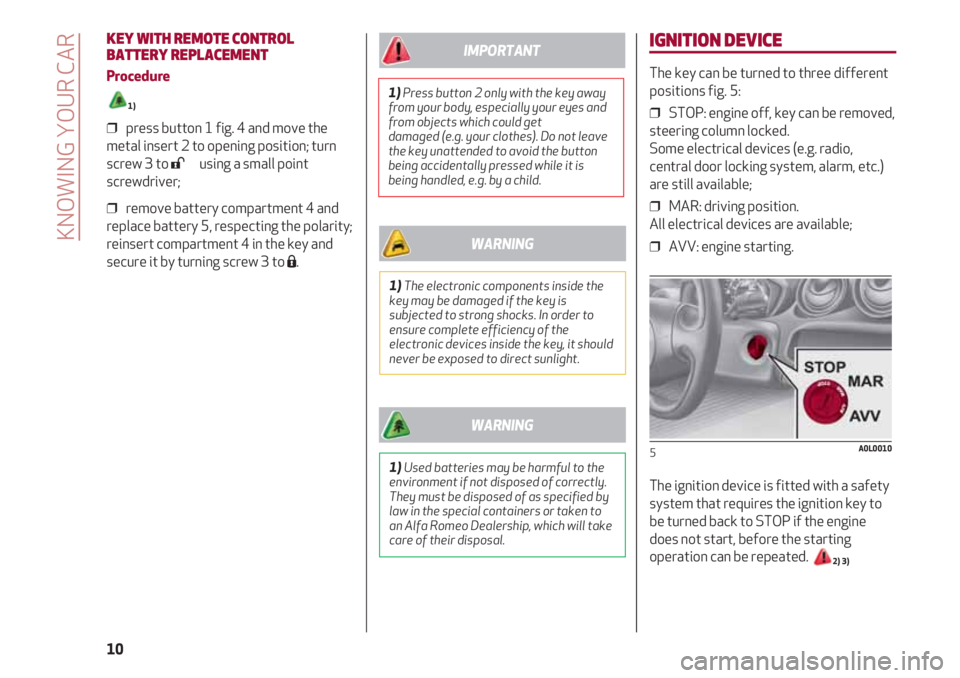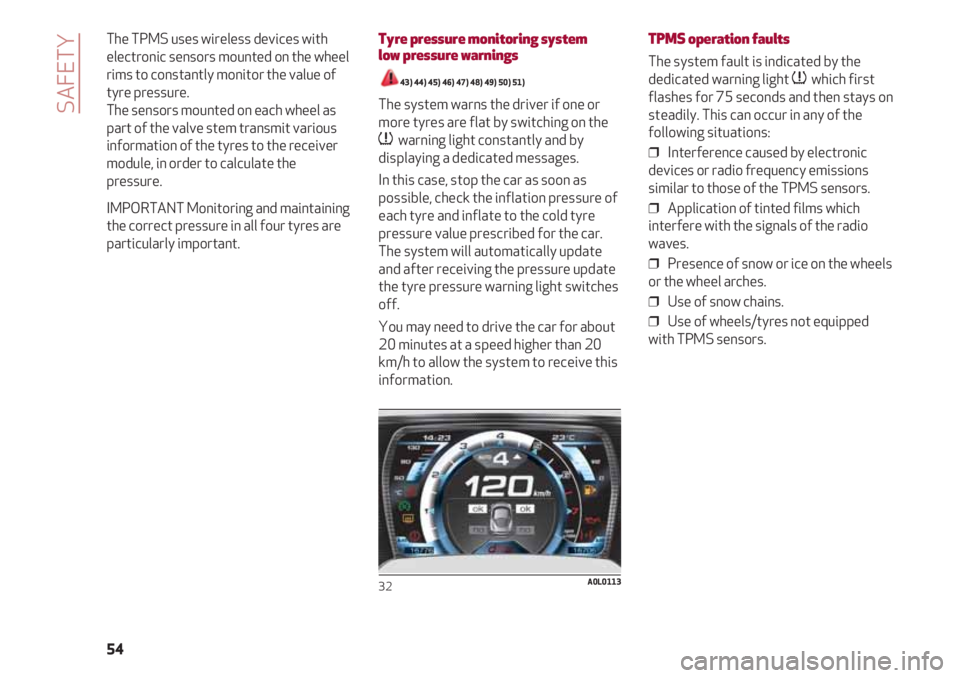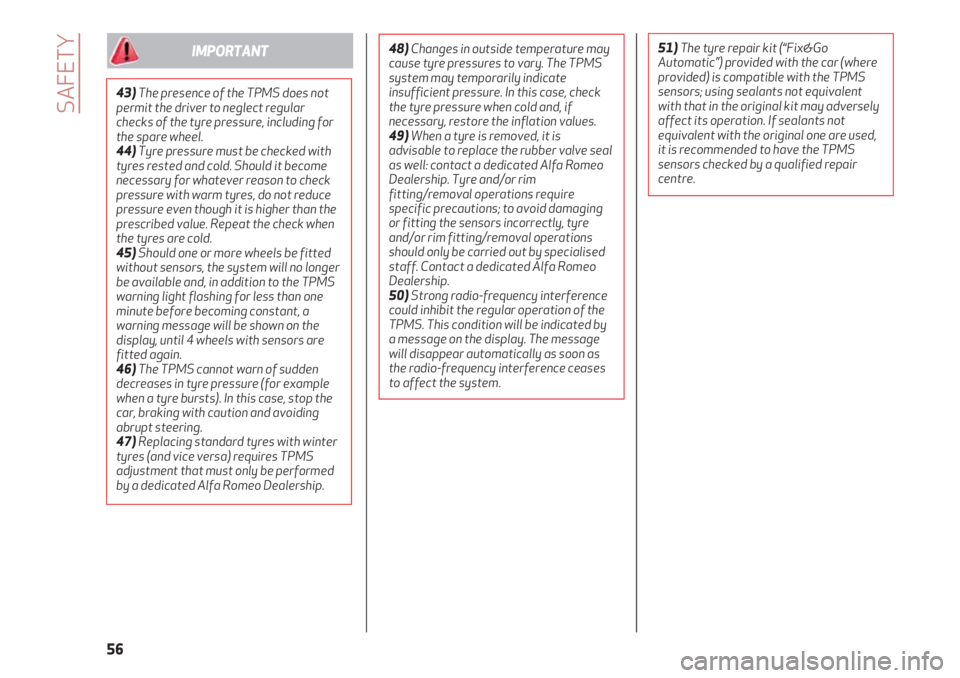radio Alfa Romeo 4C 2020 Owner handbook (in English)
[x] Cancel search | Manufacturer: ALFA ROMEO, Model Year: 2020, Model line: 4C, Model: Alfa Romeo 4C 2020Pages: 156, PDF Size: 3.06 MB
Page 12 of 156

IGNITION DEVICE
The key can be turned to three different
positions fig. 5:
❒ STOP: engine off, key can be removed,
steering column locked.
Some electrical devices (e.g. radio,
central door locking system, alarm, etc.)
are still available;
❒ MAR: driving position.
All electrical devices are available;
❒ AVV: engine starting.
The ignition device is fitted with a safety
system that requires the ignition key to
be turned back to STOP if the engine
does not start, before the starting
operation can be repeated.
2) 3)
5A0L0010
KNOWING YOUR CAR
10
KEY WITH REMOTE CONTROL
BATTERY REPLACEMENT
Procedure
1)
❒ press button 1 fig. 4 and move the
metal insert 2 to opening position; turn
screw 3 to :using a small point
screwdriver;
❒ remove battery compartment 4 and
replace battery 5, respecting the polarity;
reinsert compartment 4 in the key and
secure it by turning screw 3 to Á.
1)Press button 2 only with the key away
from your body, especially your eyes and
from objects which could get
damaged (e.g. your clothes). Do not leave
the key unattended to avoid the button
being accidentally pressed while it is
being handled, e.g. by a child.
IMPORTANT
1)Used batteries may be harmful to the
environment if not disposed of correctly.
They must be disposed of as specified by
law in the special containers or taken to
an Alfa Romeo Dealership, which will take
care of their disposal.
WARNING
1)The electronic components inside the
key may be damaged if the key is
subjected to strong shocks. In order to
ensure complete efficiency of the
electronic devices inside the key, it should
never be exposed to direct sunlight.
WARNING
Page 56 of 156

SAFETY
54 The TPMS uses wireless devices with
electronic sensors mounted on the wheel
rims to constantly monitor the value of
tyre pressure.
The sensors mounted on each wheel as
part of the valve stem transmit various
information of the tyres to the receiver
module, in order to calculate the
pressure.
IMPORTANT Monitoring and maintaining
the correct pressure in all four tyres are
particularly important.
Tyre pressure monitoring system
low pressure warnings
43) 44) 45) 46) 47) 48) 49) 50) 51)
The system warns the driver if one or
more tyres are flat by switching on the
nwarning light constantly and by
displaying a dedicated messages.
In this case, stop the car as soon as
possible, check the inflation pressure of
each tyre and inflate to the cold tyre
pressure value prescribed for the car.
The system will automatically update
and after receiving the pressure update
the tyre pressure warning light switches
off.
You may need to drive the car for about
20 minutes at a speed higher than 20
km/h to allow the system to receive this
information.
32A0L0113
TPMS operation faults
The system fault is indicated by the
dedicated warning light
nwhich first
flashes for 75 seconds and then stays on
steadily. This can occur in any of the
following situations:
❒ Interference caused by electronic
devices or radio frequency emissions
similar to those of the TPMS sensors.
❒ Application of tinted films which
interfere with the signals of the radio
waves.
❒ Presence of snow or ice on the wheels
or the wheel arches.
❒ Use of snow chains.
❒ Use of wheels/tyres not equipped
with TPMS sensors.
Page 58 of 156

SAFETY
56
43)The presence of the TPMS does not
permit the driver to neglect regular
checks of the tyre pressure, including for
the spare wheel.
44)Tyre pressure must be checked with
tyres rested and cold. Should it become
necessary for whatever reason to check
pressure with warm tyres, do not reduce
pressure even though it is higher than the
prescribed value. Repeat the check when
the tyres are cold.
45)Should one or more wheels be fitted
without sensors, the system will no longer
be available and, in addition to the TPMS
warning light flashing for less than one
minute before becoming constant, a
warning message will be shown on the
display, until 4 wheels with sensors are
fitted again.
46)The TPMS cannot warn of sudden
decreases in tyre pressure (for example
when a tyre bursts). In this case, stop the
car, braking with caution and avoiding
abrupt steering.
47)Replacing standard tyres with winter
tyres (and vice versa) requires TPMS
adjustment that must only be performed
by a dedicated Alfa Romeo Dealership.
IMPORTANT48)Changes in outside temperature may
cause tyre pressures to vary. The TPMS
system may temporarily indicate
insufficient pressure. In this case, check
the tyre pressure when cold and, if
necessary, restore the inflation values.
49)When a tyre is removed, it is
advisable to replace the rubber valve seal
as well: contact a dedicated Alfa Romeo
Dealership. Tyre and/or rim
fitting/removal operations require
specific precautions; to avoid damaging
or fitting the sensors incorrectly, tyre
and/or rim fitting/removal operations
should only be carried out by specialised
staff. Contact a dedicated Alfa Romeo
Dealership.
50)Strong radio-frequency interference
could inhibit the regular operation of the
TPMS. This condition will be indicated by
a message on the display. The message
will disappear automatically as soon as
the radio-frequency interference ceases
to affect the system.51)The tyre repair kit (“Fix&Go
Automatic”) provided with the car (where
provided) is compatible with the TPMS
sensors; using sealants not equivalent
with that in the original kit may adversely
affect its operation. If sealants not
equivalent with the original one are used,
it is recommended to have the TPMS
sensors checked by a qualified repair
centre.